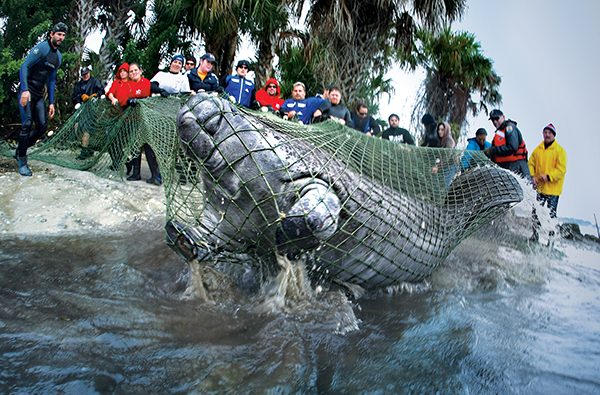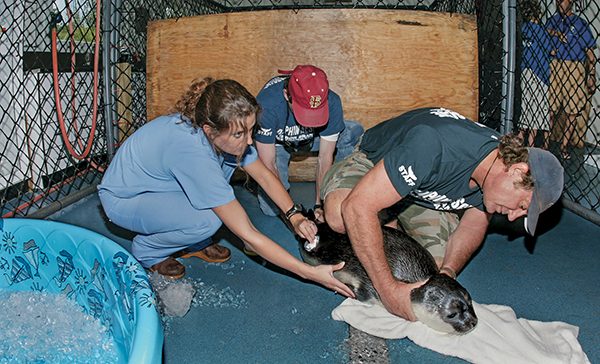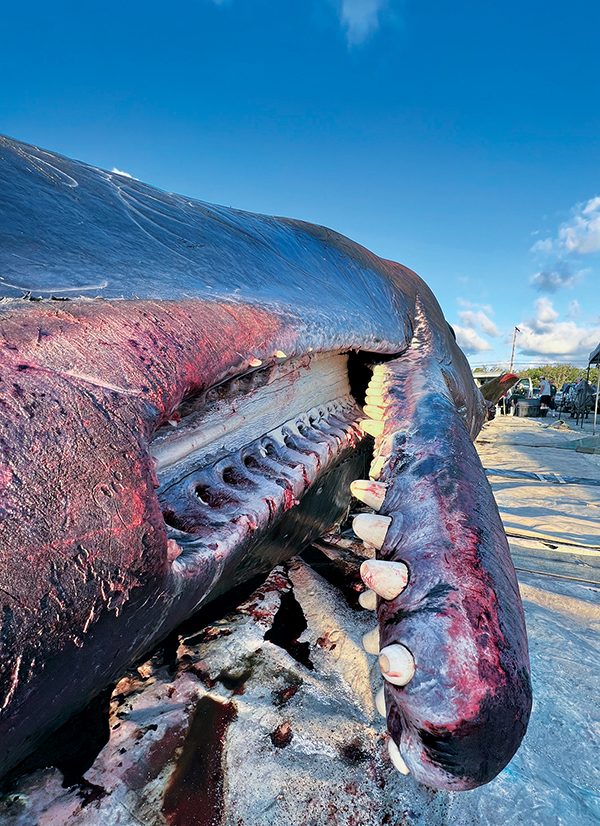Life of a marine mammal veterinarian
TALK TO ANY HUMAN UNDER THE AGE OF 13, and they have probably been asked, “What do you want to be when you grow up?” I was just 3 years old when I knew I wanted to be a veterinarian. Growing up on coasts — first Cape Cod, Massachusetts, and then Southeast Florida — I was practically raised by the Atlantic Ocean’s starfish, seahorses, sea turtle hatchlings, and so many other ocean creatures that have been my friends and confidants. I have since dedicated my life to conserving, protecting, and loving these animals. As there are few guidebooks on caring for sea creatures, my decades-long journey as a marine mammal veterinarian has been far from ordinary.
The ocean’s soothing sounds can easily lull us into serenity, but a community in dire need of conservation, research, and protection lies below the surface. The ocean’s health is in crisis, and marine mammals are the proverbial canary in the coal mine. I have traveled the world to work with a variety of marine mammals. The following are some highlights and examples of the many species, situations, and places I have been called to assess, care for, and treat marine mammals.


Related to elephants, manatees suffer from a host of human threats, including boat hits, entanglement in fishing lines, and a loss of habitat. The U.S. Geological Survey and National Park Service help conserve this threatened species by tagging and monitoring them during annual health assessments.
Gently restrained while receiving lifesaving treatment, this arctic hooded seal fully recovered and was released to his native waters in the North Atlantic.
A TALE OF TWO SPERM WHALES
We are used to swimming with numerous species of tropical fish, sharks, and dolphins while working and playing in the Florida Keys’ turquoise waters. A few miles offshore, however, the Gulf Stream serves as a highway for a large variety of pelagic species that travel immense distances, including sperm whales. Until recently, Moby-Dick was my best knowledge of these leviathans.
Over the past 20 years there have been no recorded sperm whale beachings or strandings in the Florida Keys, so it was surprising to receive a call from a Florida Fish and Wildlife Conservation Commission (FWC) officer saying that a baby sperm whale was swimming alongside a local dive boat. Everything else stops when I receive a call to help a marine mammal. Our team deployed by boat to make an initial evaluation, and we found a 10-foot (3-meter) sperm whale calf just days old. The calf took shelter under our research vessel while two equally sized tiger sharks investigated their presumed future meal.

I was in constant touch with my team and warned them to mentally prepare for the harsh reality of witnessing Mother Nature’s food chain. While the circle of life is a reality, watching a distressed baby marine mammal succumb to an agonizing death by large predators is not something veterinary school teaches you to deal with. We observed both sharks making close passes as the baby whale slowly tired and maneuvered closer to shore, where she eventually stranded rather than be eaten alive. As I prepared my medical gear in anticipation of rescue or recovery, my team alerted me that the calf had stopped breathing. It’s never easy to lose a patient, but it can be difficult to see a young life end, especially when it is an endangered species that our ecosystem so desperately needs.
The massive jaws of a stranded adult male sperm whale are impressive even in death.
It’s not uncommon for me to have more questions than answers following a postmortem examination. The calf was emaciated, presumably because mom was unavailable to provide nourishment. My only hope was that a microscopic evaluation of each organ collected would provide more compelling answers to what happened and contribute to the limited data we have to help conserve this endangered species.
Four days later we received reports of a massive whale stranded on an outer reef in the Gulf of Mexico 12 miles (19 kilometers) north of Key West, Florida. I wondered if it could be the deceased calf’s mother as I raced to the scene with the region’s stranding coordinator, Steve McCulloch, to conduct an evaluation for NOAA Fisheries. Unfortunately, the whale was deceased, and identifying it as an adult male sperm whale proved my theory wrong. To investigate further, I climbed onto the whale to collect skin samples, which can provide a treasure trove of genetic information. Fortunately, resources became available to move the whale to a local marina, where we could conduct a full necropsy the following day. NOAA Fisheries deployed additional staff and resources to collect as much information as possible, and I spent the next 12 hours examining the 47.5-foot-long (14.5-meter) sperm whale.

Sadly, a small 2.5-pound (1.1 kilogram) mass of fishing net was in the whale’s first stomach, which was likely the cause of its demise. Habitat degradation and overfishing have depleted ocean resources to the point where marine species eat anything to satisfy their hunger, with potentially deadly consequences because of our tendency to make oceans our garbage dumps. Worldwide, I find that marine mammal diseases are often the result of compromised environments.
Ingesting 2.5 pounds of fishing net was the cause of death for this 50-ton sperm whale.
ARCTIC SEALS IN THE SOUTH
A typical day in the life of a marine mammal veterinarian does not exist. I have primarily focused my career on marine mammals inhabiting southeastern U.S. waters, and it was unusual to receive a call about two seals on one of Florida’s beaches. Although I doubted that the animals were actually pinnipeds, two Arctic hooded seal pups had somehow found their way to a South Florida beach. Even more unusual was that these two pups appeared to be traveling together because they are usually a solitary species. They do not migrate until they reach sexual maturity, and their usual migratory path does not include South Florida.
We evaluated both seals at our dolphin and whale rehabilitation facility while looking for a more appropriate facility to continue their care and eventually release them. Unfortunately, only one seal survived, and that animal was transported to a New Jersey rehabilitation facility, where it would eventually be returned to the wild. During the postmortem forensic examination, I discovered that plastic spoons, plastic bags, and water bottle labels from all over the world filled the deceased pup’s stomach. As with the sperm whale, I suspect that lack of prey resulted in these wayward seals seeking better locations to satisfy their nutritional needs; the dead pup was eating anything to try and satiate his hunger, which proved fatal.

Marine mammals learn to present for routine health examinations in human care facilities.
A MASS STRANDING OF
ROUGH-TOOTHED DOLPHINS
It’s an unwritten rule that if it’s a holiday, there’s an important meeting, or it’s on the eve of a much-awaited dive vacation, a major stranding event is sure to occur. I was attending an out-of-state conference to discuss mass-stranding management when I received a call that a mass stranding of rough-toothed dolphins was taking place in South Florida. Within 30 minutes, I was on a plane.
After receiving real-time updates that some dolphins had beached, others were rolling in the surf, and many more were milling 30 yards (27 meters) offshore, my team and I consulted with NOAA Fisheries officials, and then instructed first responders and public volunteers to form a human chain in the ocean to prevent more dolphins from beaching with the rest of their pod. Inclement weather was fast approaching, however, making it unsafe to remain in the water.
Not long afterward, the remaining dolphins beached, and each dolphin had an assigned volunteer. I went down the line evaluating, sampling, and tagging each dolphin. I still have nightmares about this event; some dolphins had succumbed, and many were still in distress. I made the difficult decision to perform humane euthanasia on many of the living animals to alleviate pain and distress. Only six of the 60 animals were healthy enough for our team to attempt rehabilitation. Three of those dolphins survived to return to their native habitat wearing satellite telemetry that provided vital conservation data.
As sentinels of ocean and human health, marine mammals are living environmental barometers. We share the same oceans, we eat the same fish, and humankind will ultimately go the way of the dolphins.
THE FLORIDA MANATEE
Florida manatees are a keystone species that alerts us to environmental and habitat changes in Florida’s waterways. Weighing more than 2,000 pounds (907 kilograms), these gentle giants face innumerable threats to their habitat, including increased boat traffic, entanglement, and ingestion of marine debris. In 2021 a record 1,100 manatees died, which accounted for approximately 12 percent of the state’s population. This year wildlife officials designated Florida manatees as in crisis due to 500 deaths in an unusual mortality event (UME). The designation of a UME puts all manatee first responders, veterinarians, and scientists on high alert and prioritizes research efforts.
I have never observed a manatee without at least one scar from a boat prop. It was no surprise to find out that a manatee in Marathon, Florida, was found with severe boat propeller injuries to the head. It’s hard to imagine that any creature could survive that kind of skull trauma. A prompt rescue response to such a severe injury is critical to increasing the chances of survival. There are limited facilities available to further evaluate and treat manatees, so long transports with intense monitoring are par for the course. Moving and caring for such an enormous animal has numerous challenges, including unpredictable behavior, human safety concerns, and the added pressure of ensuring that patients from a UME arrive alive.
Fortunately, this case had a happy ending. The long transport was without incident, and subsequent surgery to remove bone fragments from the skull allowed him to return to the wild.
NOT-SO-BABY BELUGAS
For many people, the popular children’s song “Baby Beluga” is the only familiarity they have with beluga whales, also called sea canaries because of their unique vocalizations. These whales reside far from the warm Florida waters, where I spend most of my time. Like other marine species, beluga whales face numerous environmental threats, such as commercial and recreational fisheries, that compromise their nutritional health. In addition, global warming impacts the water temperatures to which marine mammals and their prey are adapted.

I recently traveled to Norway to examine and evaluate the famed “spy whale” nicknamed Hvaldimir, who arrived in Norwegian waters in 2019 wearing a harness, camera mount, and clips with the words “Equipment St. Petersburg.” No longer in human care, Hvaldimir has learned to forage for live food and now faces the threats of human interactions and living in the waters of a whaling nation. Examining this charismatic animal in below-freezing temperatures was a reminder that extreme environments come with the territory of being a marine mammal veterinarian.
Samples collected from necropsies will yield information in later laboratory analysis.
My work also extends beyond wild marine mammal populations. In prepandemic days I was called to evaluate a beluga whale living in an aquarium facility in China. This whale suffered from an undiagnosable skin condition sampled and studied by the world’s top marine mammal specialists. Working on a whale in managed care can be easier in some respects, especially with animals who volunteer for medical examinations and sampling procedures. Despite exhaustive efforts, however, we could not save this precious life, and that’s always a bad day at the office.
Nevertheless, it’s critical to take the knowledge we gain from both wild and managed-care marine species to preserve, protect, and conserve these vital apex predators that reside in our fragile oceans. AD
© Alert Diver — Q3 2022